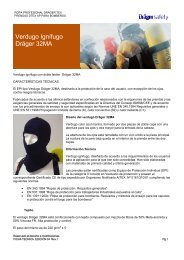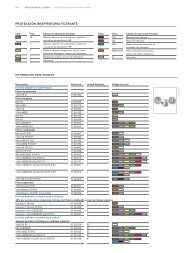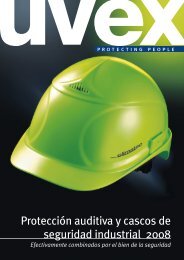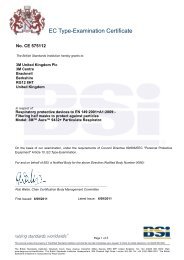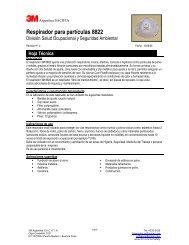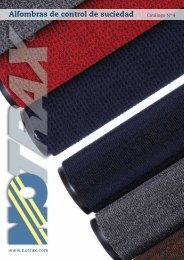uvex sil-Wear - Lp3
uvex sil-Wear - Lp3
uvex sil-Wear - Lp3
- No tags were found...
Create successful ePaper yourself
Turn your PDF publications into a flip-book with our unique Google optimized e-Paper software.
<strong>sil</strong>-<strong>Wear</strong><br />
Please pay attention!<br />
How to make the right choice<br />
To ensure a perfect fit and guarantee maximum safety when working<br />
with hazardous substances, the <strong>uvex</strong> <strong>sil</strong>-<strong>Wear</strong> range is available in<br />
a wide range of sizes. The table shows the body measurements<br />
and the corresponding <strong>uvex</strong> <strong>sil</strong>-<strong>Wear</strong> sizes. These size definitions<br />
are based on actual body measurements taken while wearing<br />
underwear but without wearing shoes.<br />
The sizes differ from standard clothes sizes, so please always<br />
select <strong>uvex</strong> <strong>sil</strong>-<strong>Wear</strong> according to your actual body measurements<br />
and not your usual clothes size!<br />
Sizes Body height in cm Chest measurement in cm<br />
S 164 – 170 cm 84 – 92 cm<br />
M 170 – 176 cm 92 – 100 cm<br />
L 176 – 182 cm 100 – 108 cm<br />
XL 182– 188 cm 108 – 116 cm<br />
XXL 188 – 194 cm 116 – 124 cm<br />
XXXL 194 – 200 cm 124 – 132 cm<br />
For optimum protection, safety and comfort.<br />
Your employees face various hazards in the course of their daily<br />
work. Everything from light liquid splashes or spillage of liquids<br />
up to work with hazardous chemicals and radioactive material in<br />
industrial use. Therefore it is important to consider the breakthrough<br />
time of permeation for protective coveralls.<br />
Permeation is the process by which a chemical moves through a<br />
protective clothing material on a molecular level. Molecules of<br />
chemicals are absorbed into the outer surface of a material, then<br />
diffuse across the fabric and are released on the inner surface.<br />
The permeation resistance of <strong>uvex</strong> fabrics to hazardous substances<br />
is determined by measuring the chemical breakthrough time of<br />
chemicals through a material. Permeation tests for our protective<br />
coveralls have been conducted according to EN ISO 6529/EN 374-3.<br />
The data listed in the table above were developed under laboratory<br />
conditions. As additional influences such as higher temperatures<br />
and mechanical strain often occur in practice, these data<br />
should only be used as a guideline. Seams and zipper closures<br />
may have lower breakthrough times, particularly when damaged<br />
or worn. The data is without commitment and does not substitute<br />
extensive suitability tests.<br />
Prior to use it is essential to check the protective coverall for any<br />
damages e.g. broken seams, defective zipper closure or other<br />
visible defects which may impair its protection.<br />
The wearer is solely responsible for deciding whether the<br />
protective coverall in use is suitable for a specific application or<br />
not.<br />
EN Class<br />
normalised breakthrough time in minutes<br />
0 immediate ( no class)<br />
1 ≥ 10<br />
2 ≥ 30<br />
3 ≥ 60<br />
4 ≥ 120<br />
5 ≥ 240<br />
6 ≥ 480<br />
For more information on test methods or permeation testing of<br />
your specific chemical please visit www.<strong>uvex</strong>-safety.de or contact<br />
our customer service department directly on 0800-66 44 893 (for<br />
calls within Germany) or +49 (0) 911-97 36-0 (for calls from outside<br />
Germany). We will be happy to help.<br />
252



